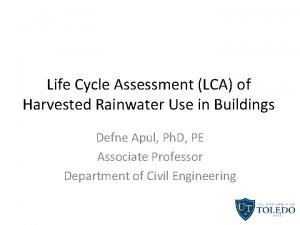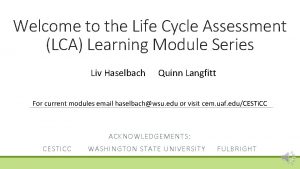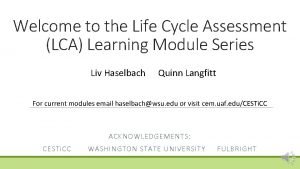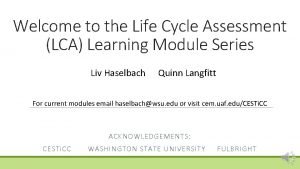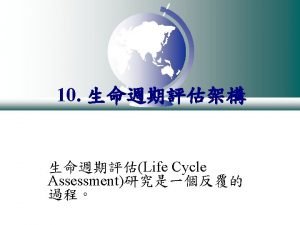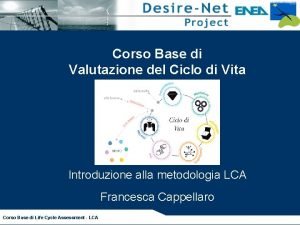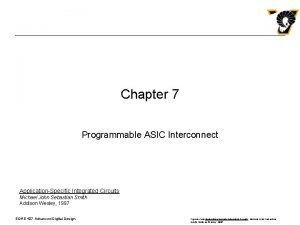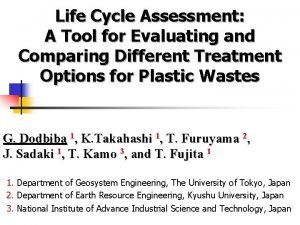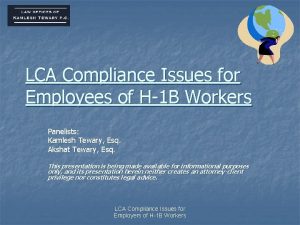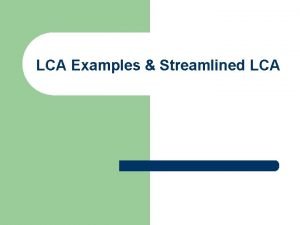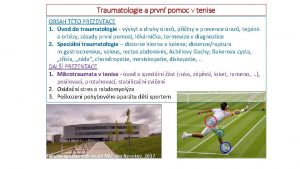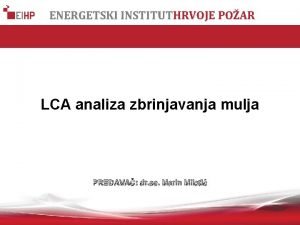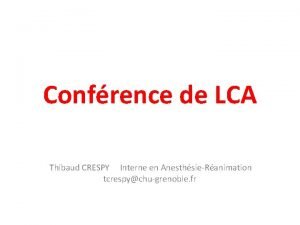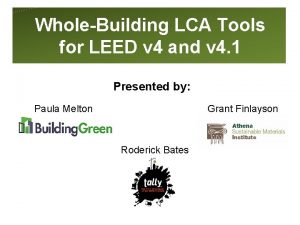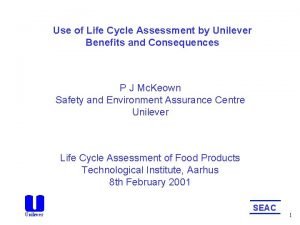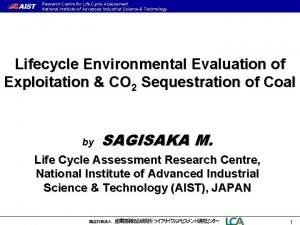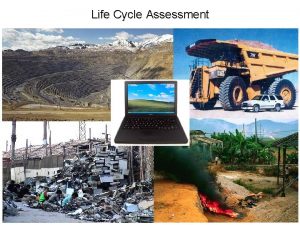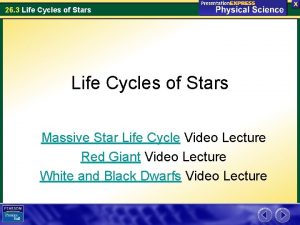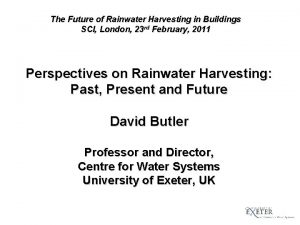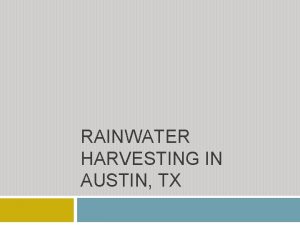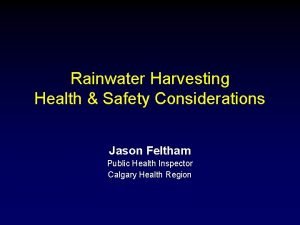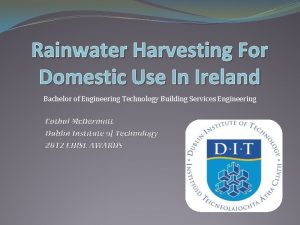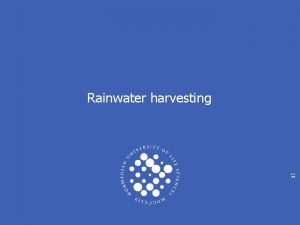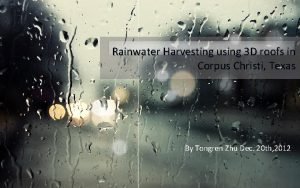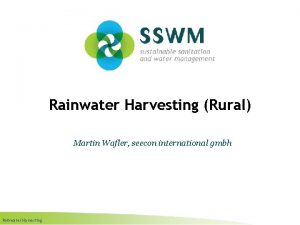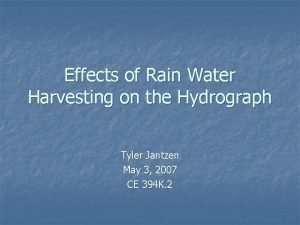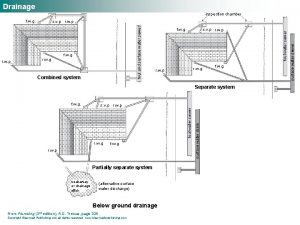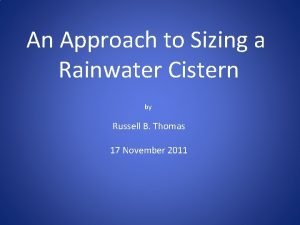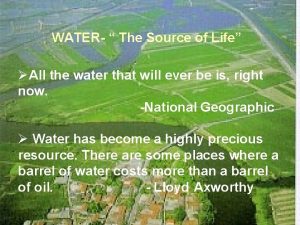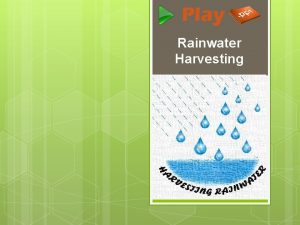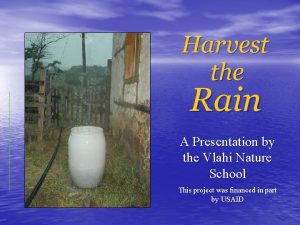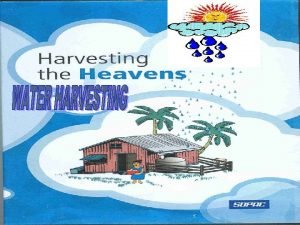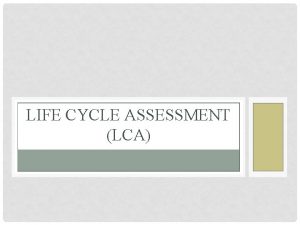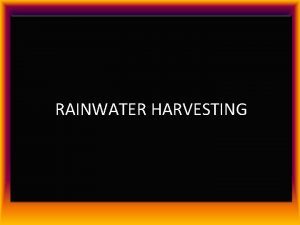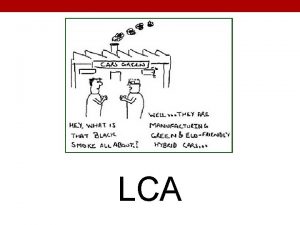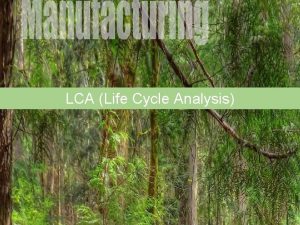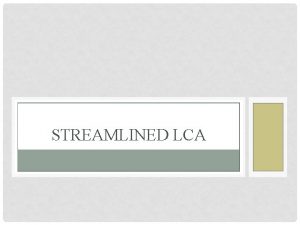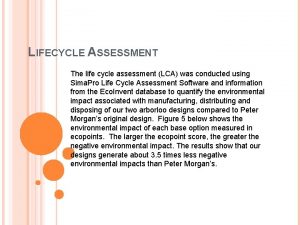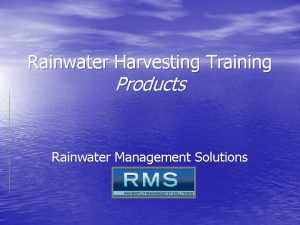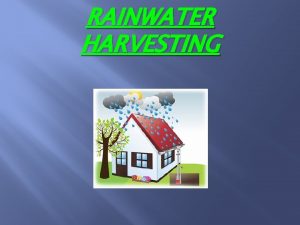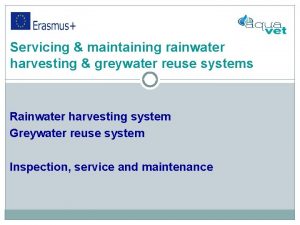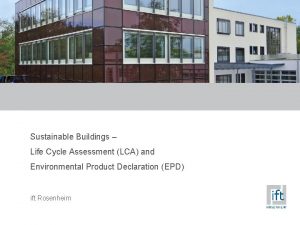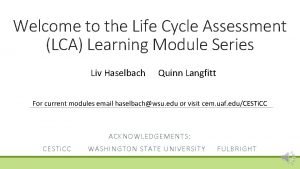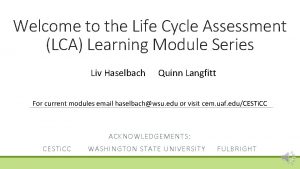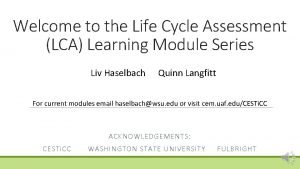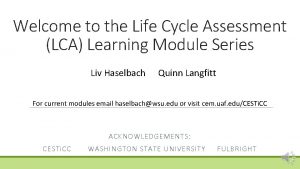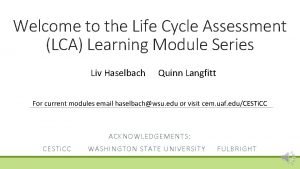Life Cycle Assessment LCA of Harvested Rainwater Use

















































- Slides: 49

Life Cycle Assessment (LCA) of Harvested Rainwater Use in Buildings Defne Apul, Ph. D, PE Associate Professor Department of Civil Engineering 1

Benefits of Rainwater Harvesting • Decentralized – Increases resiliency – No leakage • Storm water benefits • Can match water quality (Ecological Design) – Toilets • No treatment required • 27 % indoor use can be saved • Small infrastructure upgrade compared to other ecological sanitation technologies 2

Overall Goal of the Project Funding support Building scale LCA Jay, Robert, David Analysis of Decentralized Harvested Rainwater Systems using the Urban Water Infrastructure Sustainability Evaluation (u. WISE) Framework Watershed scale analysis Asset management LCA optimization Water scarcity 3

Building Scale Research Questions 1. Where are the impacts coming from? 1. What are the payback periods for RWH? 1. a. Which factors affect the life cycle impact? b. How do they affect the life cycle impact? c. Is the life cycle impact big? 4

Life Cycle Assessment (LCA)

Life Cycle Assessment (LCA)

RWH System Life Cycle Inventory • Construction o o o Cistern Filter Concrete Pad Pipes Pump • Operation o Potable Water o Wastewater o Energy use by pump

RWH System Life Cycle Inventory • Construction o o o Cistern Filter Concrete Pad Pipes Pump • Operation o Potable Water o Wastewater o Energy use by pump

RWH System Life Cycle Inventory • Construction o o o Cistern Filter Concrete Pad Pipes Pump • Operation o Potable Water o Wastewater o Energy use by pump

RWH System Life Cycle Inventory • Construction o o o Cistern Filter Concrete Pad Pipes Pump • Operation o Potable Water o Wastewater o Energy use by pump

Contribution to Life Cycle Impact Others 0. 3% Cistern 7. 3% Concrete Pad 0. 3% Energy use by pump 6. 1% Filter replacement 0. 1% Water treatment 18. 4% Wastewater treatment 67. 6% Others: üPipes üFilters üToilets üVents üOverflow drain üToilet flush with accessories üPump üSewer drain pipe üBends valves and tees üPump replacement üToilet replacement 11

Building Scale Research Questions 1. Where are the impacts coming from? 1. What are the payback periods for RWH? 1. a. Which factors affect the life cycle impact? b. How do they affect the life cycle impact? c. Is the life cycle impact big? 12

Three LCA Case Studies UT Engineering Complex (Palmer and Nitschke Halls)Building type: Educational UT Crossings Building type: Dormitory Toledo Environmental Consulting Firm Building type: Office

Engineering Complex Scenarios Payback Periods $ Energy CO 2 e 1. RWH toilet flushing (new construction) 50 years 6 years 2. RWH toilet flushing (new construction; low flush toilet) 9 years 8 years 1 year

Crossings Dorm Scenarios Payback Periods $ Energy CO 2 e 1. RWH Toilet flushing (new construction) > 75 years 7 years 21 years 2. RWH Toilet flushing (renovation) >75 years 10 years 31 years

Toledo Office Building Scenarios Payback Periods $ Energy CO 2 e 1. RWH toilet flushing (new construction) 64 years 11 years 10 years 2. RWH irrigation (new construction) 22 years 12 years 9 years 16

EEAST Model Can Analyze RWH Systems www. east. wikispaces. com EEAST – EIO Based EEAST – Process Based

Building Scale Research Questions 1. Where are the impacts coming from? 1. What are the payback periods for RWH? 1. a. Which factors affect the life cycle impact? b. How do they affect the life cycle impact? c. Is the life cycle impact big? 18

Typical Office Building Office type Medium Office Roof area (sq ft) 17, 876 No of story Occupancy 3 268 Demand/Su Roof area pply variation (sq ft) 2. 25 8, 000 to 161, 200 Occupancy variation 30 to 600 19

Typical Office Building Office type Medium Office Roof area (sq ft) 17, 876 No of story Occupancy 3 268 Roof area variation (sq ft) 8, 000 to 161, 200 Occupancy variation Demand /Supply 30 to 600 2. 25 20

Typical Office Building Office type Medium Office Roof area (sq ft) 17, 876 No of story Occupancy 3 268 Roof area variation (sq ft) 8, 000 to 161, 200 Occupancy variation Demand /Supply 30 to 600 2. 25 21

Typical Office Building Office type Medium Office Roof area (sq ft) 17, 876 No of story Occupancy 3 268 Roof area variation (sq ft) 8, 000 to 161, 200 Occupancy variation Demand /Supply 30 to 600 2. 25 22

Typical Office Building Office type Medium Office Roof area (sq ft) 17, 876 No of story Occupancy 3 268 Roof area variation (sq ft) 8, 000 to 161, 200 Occupancy variation Demand /Supply 30 to 600 2. 25 Sewer type: Combined, Separate 23

Change Roof Area 250 200 Separate Sewer Average medium office Wider building 160, 000 ft 2 roof area Narrower building 8, 000 ft 2 roof area 150 100 50 Demand to supply ratio 4. 50 4. 25 4. 00 3. 75 3. 50 3. 25 3. 00 2. 75 2. 50 2. 25 2. 00 1. 75 1. 50 1. 25 1. 00 0. 75 0. 50 0 0. 25 Life time GHG emission (MT CO 2 e) 300 24

Change Roof Area 250 Separate Sewer Average medium office Wider building 160, 000 ft 2 roof area 200 Narrower building 8, 000 ft 2 roof area 150 Wastewater treatment 100 Potable water treatment Cistern 50 4. 25 4. 00 3. 75 3. 50 3. 25 3. 00 2. 75 2. 50 2. 25 2. 00 1. 75 1. 50 1. 25 1. 00 0. 75 0. 50 0 0. 25 Life time GHG emission (MT CO 2 e) 300 Demand to supply ratio 25 200000 Waste water 0 Potable water required Energy use by pump Filter replacement Concrete Pad Cistern

Change Roof Area 250 Combined Narrower building 8, 000 ft 2 roof area Average medium office 18, 000 ft 2 roof area 200 150 100 50 250 4. 25 4. 00 3. 75 3. 50 3. 25 3. 00 2. 75 2. 50 2. 25 2. 00 Separate Sewer Average medium office Wider building 160, 000 ft 2 roof area 200 1. 75 1. 50 1. 25 1. 00 0. 75 0. 50 0. 25 0 300 Narrower building 8, 000 ft 2 roof area 150 Wastewater treatment 100 Potable water treatment Cistern 50 4. 25 4. 00 3. 75 3. 50 3. 25 3. 00 2. 75 2. 50 2. 25 2. 00 1. 75 1. 50 1. 25 1. 00 0. 75 0 0. 50 Life time GHG emission (MT CO 2 e) Wider building 160, 000 ft 2 roof area 0. 25 Life time GHG emission (MT CO 2 e) 300 Demand to supply ratio 26 200000 Waste water 0 Potable water required Energy use by pump Filter replacement Concrete Pad Cistern

Change Roof Area 250 Combined Narrower building 8, 000 ft 2 roof area Average medium office 18, 000 ft 2 roof area Stormwater treatment 200 150 Wastewater treatment 100 Potable water treatment Cistern 50 250 4. 25 4. 00 3. 75 3. 50 3. 25 3. 00 2. 75 2. 50 2. 25 2. 00 Separate Sewer Average medium office Wider building 160, 000 ft 2 roof area 200 1. 75 1. 50 1. 25 1. 00 0. 75 0. 50 0. 25 0 300 Narrower building 8, 000 ft 2 roof area 150 Wastewater treatment 100 Potable water treatment Cistern 50 4. 25 4. 00 3. 75 3. 50 3. 25 3. 00 2. 75 2. 50 2. 25 2. 00 1. 75 1. 50 1. 25 1. 00 0. 75 0 0. 50 Life time GHG emission (MT CO 2 e) Wider building 160, 000 ft 2 roof area 0. 25 Life time GHG emission (MT CO 2 e) 300 Demand to supply ratio 27 200000 Waste water 0 Potable water required Energy use by pump Filter replacement Concrete Pad Cistern

Change Occupancy More crowded building 540 Occupants Separate Sewer 250 Average medium office 270 Occupants 200 150 100 More spacious building 30 Occupants 50 0 4. 50 4. 25 4. 00 3. 75 3. 50 3. 25 3. 00 2. 75 2. 50 2. 25 2. 00 Demand to supply ratio 200000 Waste water 1. 75 1. 50 1. 25 1. 00 0. 75 0. 50 0 0. 25 Life time GHG emission (MT CO 2 e) 300 Potable water required 0. 39 0. 41 0. 43 0. 46 0. 49 Energy use by pump 0. 52 0. 55 0. 59 0. 64 Filter replacement 0. 70 0. 76 0. 84 0. 94 Concrete Pad 1. 06 1. 22 1. 44 1. 75 Cistern 28 2. 24 3. 10 5. 04

Change Occupancy More crowded building 540 Occupants Separate Sewer 250 Average medium office 270 Occupants 200 Wastewater treatment 150 100 More spacious building 30 Occupants Potable water treatment 50 Cistern 0 4. 50 4. 25 4. 00 3. 75 3. 50 3. 25 3. 00 2. 75 2. 50 2. 25 2. 00 Demand to supply ratio 200000 Waste water 1. 75 1. 50 1. 25 1. 00 0. 75 0. 50 0 0. 25 Life time GHG emission (MT CO 2 e) 300 Potable water required 0. 39 0. 41 0. 43 0. 46 0. 49 Energy use by pump 0. 52 0. 55 0. 59 0. 64 Filter replacement 0. 70 0. 76 0. 84 0. 94 Concrete Pad 1. 06 1. 22 1. 44 1. 75 Cistern 29 2. 24 3. 10 5. 04

Change Occupancy 250 Average medium office 270 Occupants 200 150 More spacious building 30 Occupants 100 50 4. 25 4. 00 3. 75 3. 50 3. 25 3. 00 More crowded building 540 Occupants Separate Sewer 250 2. 75 2. 50 2. 25 2. 00 1. 75 1. 50 1. 25 1. 00 0. 75 0. 50 0 300 Average medium office 270 Occupants 200 Wastewater treatment 150 100 More spacious building 30 Occupants Potable water treatment 50 Cistern 0 4. 50 4. 25 4. 00 3. 75 3. 50 3. 25 3. 00 2. 75 2. 50 2. 25 2. 00 Demand to supply ratio 200000 Waste water 1. 75 1. 50 1. 25 1. 00 0. 75 0. 50 0 0. 25 Life time GHG emission (MT CO 2 e) More crowded building 540 Occupants Combined 0. 25 Life time GHG emission (MT CO 2 e) 300 Potable water required 0. 39 0. 41 0. 43 0. 46 0. 49 Energy use by pump 0. 52 0. 55 0. 59 0. 64 Filter replacement 0. 70 0. 76 0. 84 0. 94 Concrete Pad 1. 06 1. 22 1. 44 1. 75 Cistern 30 2. 24 3. 10 5. 04

Change Occupancy 250 Wastewater treatment More spacious building 30 Occupants Potable water treatment 100 50 4. 25 4. 00 3. 75 3. 50 3. 25 3. 00 Cistern More crowded building 540 Occupants Separate Sewer 250 2. 75 2. 50 2. 25 2. 00 1. 75 1. 50 1. 25 1. 00 0. 75 0. 50 0 300 Average medium office 270 Occupants 200 Wastewater treatment 150 100 More spacious building 30 Occupants Potable water treatment 50 Cistern 0 4. 50 4. 25 4. 00 3. 75 3. 50 3. 25 3. 00 2. 75 2. 50 2. 25 2. 00 Demand to supply ratio 200000 Waste water 1. 75 1. 50 1. 25 1. 00 0. 75 0. 50 0 0. 25 Life time GHG emission (MT CO 2 e) Stormwater treatment Average medium office 270 Occupants 200 150 More crowded building 540 Occupants Combined 0. 25 Life time GHG emission (MT CO 2 e) 300 Potable water required 0. 39 0. 41 0. 43 0. 46 0. 49 Energy use by pump 0. 52 0. 55 0. 59 0. 64 Filter replacement 0. 70 0. 76 0. 84 0. 94 Concrete Pad 1. 06 1. 22 1. 44 1. 75 Cistern 31 2. 24 3. 10 5. 04

Change Occupancy 250 Wastewater treatment More spacious building 30 Occupants Potable water treatment 100 50 4. 25 4. 00 3. 75 3. 50 3. 25 3. 00 Cistern More crowded building 540 Occupants Separate Sewer 250 2. 75 2. 50 2. 25 2. 00 1. 75 1. 50 1. 25 1. 00 0. 75 0. 50 0 300 Average medium office 270 Occupants 200 Wastewater treatment 150 100 More spacious building 30 Occupants Potable water treatment 50 Cistern 0 4. 50 4. 25 4. 00 3. 75 3. 50 3. 25 3. 00 2. 75 2. 50 2. 25 2. 00 Demand to supply ratio 200000 Waste water 1. 75 1. 50 1. 25 1. 00 0. 75 0. 50 0 0. 25 Life time GHG emission (MT CO 2 e) Stormwater treatment Average medium office 270 Occupants 200 150 More crowded building 540 Occupants Combined 0. 25 Life time GHG emission (MT CO 2 e) 300 Potable water required 0. 39 0. 41 0. 43 0. 46 0. 49 Energy use by pump 0. 52 0. 55 0. 59 0. 64 Filter replacement 0. 70 0. 76 0. 84 0. 94 Concrete Pad 1. 06 1. 22 1. 44 1. 75 Cistern 32 2. 24 3. 10 5. 04

Building Scale Research Questions 1. Where are the impacts coming from? 1. What are the payback periods for RWH? 1. a. Which factors affect the life cycle impact? b. How do they affect the life cycle impact? c. Is the life cycle impact big? 33

Typical Office Building Office type Roof area (sq ft) No of story Total Occupancy Small Office 5, 502 1 28 Medium 53, 628 Office Large Office 498, 588 3 268 12 2493 Demand/Su Roof area pply variation (sq ft) 0. 75 1, 000 to 10, 500 2. 25 8, 000 to 161, 200 0. 90 100, 000 to 1, 050, 000 Occupancy variation 6 to 101 30 to 600 200 to 4, 950 Sewer type: Combined, Separate 34

Life Cycle Impacts 3. 00 RWHS small office 2. 00 1. 00 RWHS medium office 0. 00 RWHS Large office 0. 0 0. 5 1. 0 1. 5 2. 0 2. 5 3. 0 35

Change Roof Area 250 Combined Narrower building 8, 000 ft 2 roof area Average medium office 18, 000 ft 2 roof area 200 150 100 50 250 4. 25 4. 00 3. 75 3. 50 3. 25 3. 00 2. 75 2. 50 2. 25 2. 00 Separate Sewer Average medium office Wider building 160, 000 ft 2 roof area 200 1. 75 1. 50 1. 25 1. 00 0. 75 0. 50 0. 25 0 300 Narrower building 8, 000 ft 2 roof area 150 100 50 4. 25 4. 00 3. 75 3. 50 3. 25 3. 00 2. 75 2. 50 2. 25 2. 00 1. 75 1. 50 1. 25 1. 00 0. 75 0 0. 50 Life time GHG emission (MT CO 2 e) Wider building 160, 000 ft 2 roof area 0. 25 Life time GHG emission (MT CO 2 e) 300 Demand to supply ratio 36 200000 Waste water 0 Potable water required Energy use by pump Filter replacement Concrete Pad Cistern

Change Occupancy 250 Average medium office 270 Occupants 200 150 More spacious building 30 Occupants 100 50 4. 00 4. 25 4. 50 3. 75 3. 50 3. 25 3. 00 More crowded building 540 Occupants Separate Sewer 250 2. 75 2. 50 2. 25 2. 00 1. 75 1. 50 1. 25 1. 00 0. 75 0. 50 0 300 Average medium office 270 Occupants 200 150 100 More spacious building 30 Occupants 50 0 3. 75 3. 50 3. 25 3. 00 2. 75 2. 50 2. 25 2. 00 Demand to supply ratio 200000 Waste water 1. 75 1. 50 1. 25 1. 00 0. 75 0. 50 0 0. 25 Life time GHG emission (MT CO 2 e) More crowded building 540 Occupants Combined 0. 25 Life time GHG emission (MT CO 2 e) 300 Potable water required 0. 39 0. 41 0. 43 0. 46 0. 49 Energy use by pump 0. 52 0. 55 0. 59 0. 64 Filter replacement 0. 70 0. 76 0. 84 0. 94 Concrete Pad 1. 06 1. 22 1. 44 1. 75 Cistern 37 2. 24 3. 10 5. 04

38

Life Cycle Impacts 3. 00 RWHS small office 2. 00 1. 00 RWHS medium office 0. 00 RWHS Large office 0. 0 0. 5 1. 0 1. 5 2. 0 2. 5 3. 0 39

Life Cycle Person Impacts 3. 00 RWHS small office 2. 00 1. 00 RWHS medium office 0. 00 RWHS Large office 0. 0 0. 5 1. 0 1. 5 2. 0 2. 5 3. 0 40

Building Scale Research Questions 1. Where are the impacts coming from? 1. What are the payback periods for RWH? 1. a. Which factors affect the life cycle impact? Sewer type, occupancy, roof area supply/demand ration Mainly from operation phase, cistern also has reasonable impact It varies! b. How do they affect the life cycle impact? It is complicated! c. Is the life cycle impact big? The GHG emissions from toilet flushing are small compared to driving or electricity use. 41

Thank You 42

Extra Slides 43

Per Person Impacts: BAU and RWH 44

Alternative Toilet Designs Toilets With or without urine separation Flush water source Municipal potable water Rainwater Local groundwater Grey water Flushed water management Without water Constructed wetlands Composting toilet WWTP Living machines

46

LCA Model Structure 47

Change Roof Area 250 Combined Narrower building 8, 000 ft 2 roof area Average medium office 18, 000 ft 2 roof area 200 150 100 50 250 4. 25 4. 00 3. 75 3. 50 3. 25 3. 00 2. 75 2. 50 2. 25 2. 00 Separate Sewer Average medium office Wider building 160, 000 ft 2 roof area 200 1. 75 1. 50 1. 25 1. 00 0. 75 0. 50 0. 25 0 300 Narrower building 8, 000 ft 2 roof area 150 100 50 4. 25 4. 00 3. 75 3. 50 3. 25 3. 00 2. 75 2. 50 2. 25 2. 00 1. 75 1. 50 1. 25 1. 00 0. 75 0 0. 50 Life time GHG emission (MT CO 2 e) Wider building 160, 000 ft 2 roof area 0. 25 Life time GHG emission (MT CO 2 e) 300 Demand to supply ratio 48 200000 Waste water 0 Potable water required Energy use by pump Filter replacement Concrete Pad Cistern

Change Occupancy 250 Average medium office 270 Occupants 200 150 More spacious building 30 Occupants 100 50 4. 00 4. 25 4. 50 3. 75 3. 50 3. 25 3. 00 More crowded building 540 Occupants Separate Sewer 250 2. 75 2. 50 2. 25 2. 00 1. 75 1. 50 1. 25 1. 00 0. 75 0. 50 0 300 Average medium office 270 Occupants 200 150 100 More spacious building 30 Occupants 50 0 3. 75 3. 50 3. 25 3. 00 2. 75 2. 50 2. 25 2. 00 Demand to supply ratio 200000 Waste water 1. 75 1. 50 1. 25 1. 00 0. 75 0. 50 0 0. 25 Life time GHG emission (MT CO 2 e) More crowded building 540 Occupants Combined 0. 25 Life time GHG emission (MT CO 2 e) 300 Potable water required 0. 39 0. 41 0. 43 0. 46 0. 49 Energy use by pump 0. 52 0. 55 0. 59 0. 64 Filter replacement 0. 70 0. 76 0. 84 0. 94 Concrete Pad 1. 06 1. 22 1. 44 1. 75 Cistern 49 2. 24 3. 10 5. 04
 Life cycle assessment of rainwater harvesting
Life cycle assessment of rainwater harvesting A small, hard, dry seed harvested for human consumption.
A small, hard, dry seed harvested for human consumption. Lca evaluation module
Lca evaluation module Simapro 9 tutorial
Simapro 9 tutorial Bees lca
Bees lca Latent class analysis stata
Latent class analysis stata Iso14040
Iso14040 Intel immigration sponsorship
Intel immigration sponsorship Fasi lca
Fasi lca Diagramme de flux lca
Diagramme de flux lca Programmable asic
Programmable asic Randomisation en cluster
Randomisation en cluster Lca framework
Lca framework Lca payout cognizant
Lca payout cognizant Lca banrisul
Lca banrisul Investigation task
Investigation task Lca lad
Lca lad Hensriks
Hensriks Lca
Lca Diagramme de flux lca
Diagramme de flux lca Distenze lca
Distenze lca Analiza lca
Analiza lca Glossaire lca cnci
Glossaire lca cnci Whole building life cycle assessment wblca
Whole building life cycle assessment wblca Unilever supply chain strategy
Unilever supply chain strategy Life cycle assessment
Life cycle assessment Life cycle assessment
Life cycle assessment Section 26.3 life cycles of stars
Section 26.3 life cycles of stars Future of rainwater harvesting
Future of rainwater harvesting Rainwater tanks austin
Rainwater tanks austin Rainwater harvesting calgary
Rainwater harvesting calgary Rainwater tanks ireland
Rainwater tanks ireland Bibliography of rainwater harvesting
Bibliography of rainwater harvesting Droofs
Droofs Function of rainwater harvesting
Function of rainwater harvesting Hypothesis of rainwater harvesting
Hypothesis of rainwater harvesting Rainwater inspection chamber
Rainwater inspection chamber Rainwater cistern sizing
Rainwater cistern sizing Coarse mesh in rainwater harvesting
Coarse mesh in rainwater harvesting What is good nitrogen fertilizer
What is good nitrogen fertilizer Rainwater harvesting introduction
Rainwater harvesting introduction Rainwater harvesting systems cork
Rainwater harvesting systems cork Rain water harvesting conclusion
Rain water harvesting conclusion Rain water harvesting conclusion
Rain water harvesting conclusion Principles of portfolio assessment
Principles of portfolio assessment Static assessment vs dynamic assessment
Static assessment vs dynamic assessment Portfolio assessment matches assessment to teaching
Portfolio assessment matches assessment to teaching Product-oriented performance-based assessment
Product-oriented performance-based assessment Common core formative assessments
Common core formative assessments The decifractator game
The decifractator game
